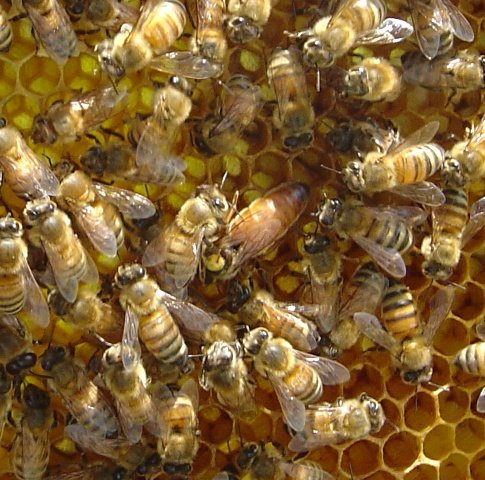It is the last week of April and the flowers are just starting to bloom!
Three weeks ago we had our first Crocus pop its head out of the ground and open up so the bees could collect some fresh pollen.
Right: Worker bee brings white pollen back to the hive
We have had a lot of rainy weather, which is typical for this time of year, but the temperatures have been cooler as well. My year to year records show that we are running about three weeks behind last year, and about a week behind “normal” with the spring foliage.
On warm days the bees are flying, bringing back small bundles of yellow and white pollen on their hind legs. This could only mean that there is brood rearing taking place inside the hive.
This is the time of year that the bees need to quickly build up in number s in order to take advantage of the spring honey flow we have here on the cape.
Starting mid May to around the end of July is our only real honey producing time here on Cape Cod.
This year the cooler temperatures have hindered the buildup. At least in my hives!

Right: A worker bee collects pollen from a white Crocus flower
This weekend I will begin to feed them sugar syrup, which will help stimulate brood rearing as well.
I guess when the queen sees supplies being brought into the hive she feels comfortable enough to begin laying and laying eggs.
Left: Another worker bee collects nectar
Our scheduled delivery of packaged bees from down south have bee delayed for a second time this season. I have not heard the reason why, but perhaps they are having as much trouble with their bees as we are here in the North East.
Temperatures reached the high 60’s yesterday and today allowing an increase in the bees activities.
With the forsythia in full bloom there is much pollen to be gathered. My peach tree is just starting to bloom and I know the Red Maple is not far behind.
Right: Pollen patties and sugar candy placed in the hives allow the workers to feed even on cold wet days when they cannot forrage.
My battle with the mice in the shed continues.
Each time I pick up a box, or a bucket I find the evidence of mice damage. Chewed gloves, newspaper, and table cloths litter the corners of the space.
I found one dead family inside the garden tool box.
How they managed to get in will remain a mystery forever.
But these things too will pass. And for now I am anticipating a good honey season.
After the last two bad ones, it is the least that mother nature can do,







































